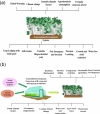Controlled Environment Ecosystem: A Cutting-Edge Technology in Speed Breeding
- PMID: 39005787
- PMCID: PMC11238293
- DOI: 10.1021/acsomega.3c09060
Controlled Environment Ecosystem: A Cutting-Edge Technology in Speed Breeding
Abstract
The controlled environment ecosystem is a meticulously designed plant growing chamber utilized for cultivating biofortified crops and microgreens, addressing hidden hunger and malnutrition prevalent in the growing population. The integration of speed breeding within such controlled environments effectively eradicates morphological disruptions encountered in traditional breeding methods such as inbreeding depression, male sterility, self-incompatibility, embryo abortion, and other unsuccessful attempts. In contrast to the unpredictable climate conditions that often prolong breeding cycles to 10-15 years in traditional breeding and 4-5 years in transgenic breeding within open ecosystems, speed breeding techniques expedite the achievement of breeding objectives and F1-F6 generations within 2-3 years under controlled growing conditions. In comparison, traditional breeding may take 5-10 years for plant population line creation, 3-5 years for field trials, and 1-2 years for variety release. The effectiveness of speed breeding in trait improvement and population line development varies across different crops, requiring approximately 4 generations in rice and groundnut, 5 generations in soybean, pea, and oat, 6 generations in sorghum, Amaranthus sp., and subterranean clover, 6-7 generations in bread wheat, durum wheat, and chickpea, 7 generations in broad bean, 8 generations in lentil, and 10 generations in Arabidopsis thaliana annually within controlled environment ecosystems. Artificial intelligence leverages neural networks and algorithm models to screen phenotypic traits and assess their role in diverse crop species. Moreover, in controlled environment systems, mechanistic models combined with machine learning effectively regulate stable nutrient use efficiency, water use efficiency, photosynthetic assimilation product, metabolic use efficiency, climatic factors, greenhouse gas emissions, carbon sequestration, and carbon footprints. However, any negligence, even minor, in maintaining optimal photoperiodism, temperature, humidity, and controlling pests or diseases can lead to the deterioration of crop trials and speed breeding techniques within the controlled environment system. Further comparative studies are imperative to comprehend and justify the efficacy of climate management techniques in controlled environment ecosystems compared to natural environments, with or without soil.
© 2024 The Authors. Published by American Chemical Society.
Conflict of interest statement
The authors declare no competing financial interest.
Figures
References
-
- Zhao Z.; Xu T.; Pan X.; Susanti; White J. C.; Hu X.; Miao Y.; Demokritou P.; Ng K. W. Sustainable nutrient substrates for enhanced seedling development in hydroponics. ACS Sustainable Chem. Eng. 2022, 10, 8506–8516. 10.1021/acssuschemeng.2c01668. - DOI
-
- Mitchell C. A. History of controlled environment horticulture: Indoor farming and its key technologies. HortScience 2022, 57, 247–256. 10.21273/HORTSCI16159-21. - DOI
-
- Sharma A.; Hazarika M.; Heisnam P.; Pandey H.; Devadas V. S.; Wangsu M. Controlled Environment Ecosystem: A plant growth system to combat climate change through soilless culture. Crop Design 2024, 3, 100044. 10.1016/j.cropd.2023.100044. - DOI
-
- Thomson A.; Price G. W.; Arnold P.; Dixon M.; Graham T. Review of the potential for recycling CO2 from organic waste composting into plant production under controlled environment agriculture. Journal of Cleaner Production 2022, 333, 130051. 10.1016/j.jclepro.2021.130051. - DOI
Publication types
LinkOut - more resources
Full Text Sources


